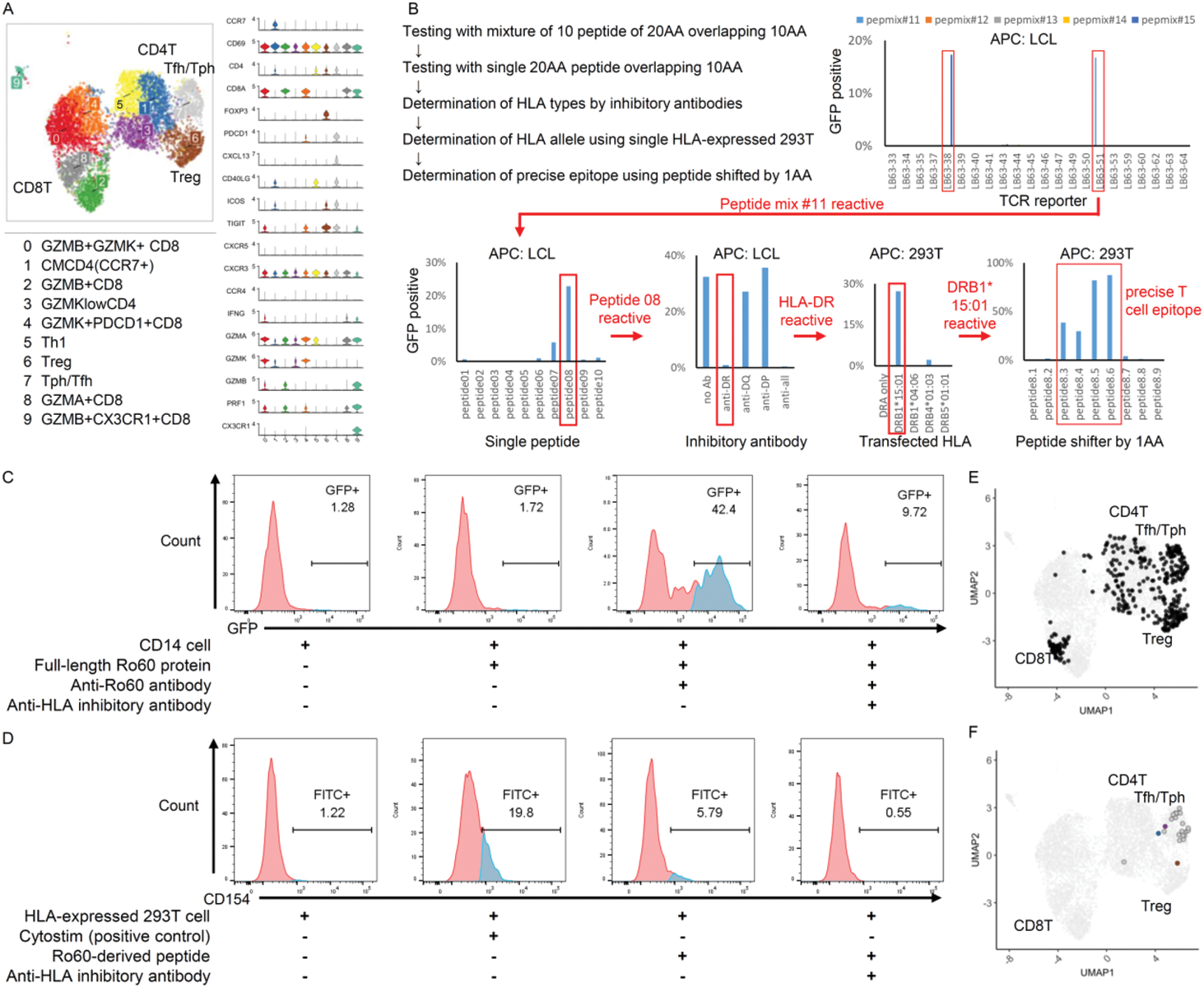

Background: Sjögren’s disease (SjD) is an autoimmune disease characterized by lymphocytic infiltration of exocrine glands. The antigen specificity of T cells has been studied for more than two decades, and although the presence of T cells reacting to α-amylase, M3R, DDIAS, and MAP3K4 has been sporadically reported, the major corresponding antigen of T cells at the lesion site has not been identified. We comprehensively analyzed the antigen specificity of B cells infiltrating the salivary glands of this disease and found that approximately 30% of the infiltrated cells produced disease-specific autoantibodies [1]. Since affinity maturation occurred in these autoantibodies and ectopic lymphoid structures were often observed in lesions of SjD, we hypothesized that CD4 T cells with the same antigen specificity may help B cells.
Objectives: The aim of this study was to determine the antigen specificity of CD4 T cells in salivary glands in SjD.
Methods: We performed single-cell gene expression and TCR analysis of salivary glands of patients with serum anti-Ro60 antibody-positive SjD. TCRs from CD4 T cells with clonal proliferation in the disease lesions were expressed in TCR reporter cells that express GFP upon stimulation of NFAT. Lymphoblastoid cell lines (LCLs), HLA-overexpressed cell lines, and peripheral monocytes phagocytosed of immune complexes were prepared as antigen presenting cells (APCs). APCs and TCR reporters were cocultured with Ro60-derived peptides. The reactivity of TCR-overexpressed primary T cells were also examined.
Results: We first identified 10 T cell clusters by clustering analysis based on gene expression; the 4108 CD4 T cells were classified into five clusters as shown in Figure 1A. From the TCRs of these cells, we selected TCRs that showed clonal proliferation and expressed them on reporter cells to create a TCR reporter library. Over 150 TCR reporter cells derived from seven patients, 10 different TCRs reacted with APCs loading Ro60-derived peptide. The details of HLA alleles and peptide sequences corresponding to each TCR were identified (Figure 1B); the HLAs to which the TCRs reacted were not only DR, but also DQ and DP. These autoreactive TCR reporters could react with monocytes phagocytosed with immune complexes containing full-length Ro60 protein, indicating that the identified peptides can be naturally processed and presented in vivo (Figure 1C). Primary CD4 T cells from healthy individuals with forced expression of autoreactive TCRs could also reactive to the corresponding HLA/peptide complexes, indicating that the identified TCRs are functional (Figure 1D). Ro60 reactive CD4 T cells were significantly enriched in Tph/Tfh cluster (p-value < 2.2e-16, Chi-squared test), indicating that those CD4 T cells contribute to autoantibody production from B cells at the lesion site (Figure 1E,F).
Summary of CD4 T cell specificity analysis. (A) scRNA-seq + TCR-seq analysis were performed using 10x platform. The clusters of salivary gland-derived T cells were shown in UMAP. (B) The strategy of T cell epitope determination and the representative results were shown. Peptides of 20AA with overlapping 10AA each were prepared over full length of Ro60, and Ro60-specific TCRs were selected with a mixture of peptides. T cell epitope were roughly located with a single peptide. HLA types were determined with inhibitory antibodies against each of HLA-DR, DQ and DP. The HLA alleles were determined in 293T cells expressing one of the two or four HLAs that the patient had. Finally, the precise T cell epitope was determined with peptides shifted by 1 AA. (C) TCR reporter cells were cocultured with peripheral CD14 cells with Ro60, Ro60 immune complex (Ro60+anti-Ro60 antibody), or inhibitory antibody. GFP expression of TCR reporter cells were shown. (D) Ro60-reactive TCR was forced to express on primary CD4 T cells from healthy individual. Those T cells were cocultured with HLA-expressed 293T cells with Ro60-derived peptide and inhibitory antibody. The expression of CD154, which is specificaly expressed after stimulation of specific antigen via TCR, on CD4 T cells were shown. (E) T cells tested for TCR reactivity were plotted on UMAP. (F) Ro60-reacted T cells, colored by T cell clusters, were plotted on UMAP.

Conclusion: Ro60-specific Tph/Tfh CD4T cells are present in the salivary glands and may contribute to autoantibody production from B cells. The major T cell autoantigen in systemic autoimmune diseases were identified for the first time, providing important clues for understanding disease pathogenesis and for the future development of antigen-specific immunosuppressive therapies.
REFERENCES: [1] Takeshita M, Suzuki K, Kaneda Y, Yamane H, Ikeura K, Sato H, Kato S, Tsunoda T, Arase H, Takeuchi T. Antigen-driven selection of antibodies against SSA, SSB, and the centromere “complex”, including a novel antigen, MIS12 complex. Ann Rheum Dis. 2020;79(1):150-158.
Acknowledgements: This research was supported by JSPS KAKENHI and Keio University Academic Development Funds.
Disclosure of Interests: Masaru Takeshita JSR Corporation, Jun Inamo: None declared, Katsuya Suzuki: None declared, Yuko Kaneko: None declared.
© The Authors 2025. This abstract is an open access article published in Annals of Rheumatic Diseases under the CC BY-NC-ND license (